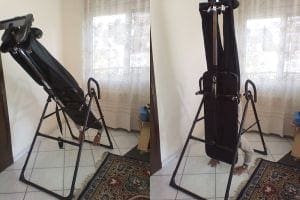statFor some women, it's about making an elegantement at special events or being a couple…

What is “Inversion Therapy”?
 Severe back pain can be debilitating, greatly limiting freedom of movement and enjoyment of life. Spinal vertebrae may sometimes become misaligned, causing nerves to become compressed. Because nerves are the body’s channels of communication, compression or pinching interferes with the body’s signaling, leading to pain and occasionally incorrect function. Sitting or standing places pressure on the vertebrae as they support the upper body. By utilizing inversion therapy, the pressure is reversed, sometimes leading to relief of symptoms.
Severe back pain can be debilitating, greatly limiting freedom of movement and enjoyment of life. Spinal vertebrae may sometimes become misaligned, causing nerves to become compressed. Because nerves are the body’s channels of communication, compression or pinching interferes with the body’s signaling, leading to pain and occasionally incorrect function. Sitting or standing places pressure on the vertebrae as they support the upper body. By utilizing inversion therapy, the pressure is reversed, sometimes leading to relief of symptoms.
Such inversion can be achieved by use of an inversion table that lets the patient rest on an incline with his or her head at the bottom and feet at the top. Some tables can hold the person vertically upside-down. Another device, called “gravity boots,” allows the person to hang by his or her feet. Each of these methods is a form of spinal decompression or spinal traction that can provide relief without the need for more expensive equipment, dangerous surgery or drugs with harmful side effects.
Many people have received very positive results from inversion therapy. One patient in Maryland purchased an inversion table for home and loved the results, though they said it was like “Hanging upside-down on the monkey bars at the park: Priceless.” Nevertheless, you should always be cautious when beginning any new exercise or stretching program, especially one that is intended to treat specific health problems (which would often be the case with techniques intended to decompress the spine). Depending on your own situation, your chiropractor may recommend some combination of decompression therapy, manual adjustments, targeted exercises and nutritional changes that can help reduce your symptoms.
Inversion therapy is not for everyone. People with high blood pressure, eye disease, heart problems, pregnancy or acid reflux disease should not use inversion therapy. Dr. Celeste Robb-Nicholson is editor-in-chief of Harvard Women’s Health Watch. She wrote that inversion therapy can increase blood pressure and pressure on your eyes, plus it can lower your heart rate. After all, our bodies were not built to be upside-down.
You should also be aware that some patients have reported side effects from inversion therapy. For some, this has included an actual worsening of symptoms or the appearance of new ones. One Illinois patient reported, “After 6 treatments my pain has increased from a 5 to an 8–9 and I now have severe leg pain and difficulty standing straight!”
Another patient from New York wrote, “Within 30 minutes of leaving the office I could not turn my head. A week later, I still cannot do so without severe pain (never had any neck pain before)…. I am glad that a lot of people have been helped, but I was a perfect candidate on paper and it didn’t do anything positive for me.”
Unfortunate cases like these teach three very important lessons:
- It’s very important to receive a complete evaluation from a qualified healthcare professional before making decisions about back pain treatment. Back pain may be caused by a wide variety of factors. An experienced chiropractic physician can help you understand your specific situation as well as the potential benefits and risks of various treatment choices.
- Patients suffering from the same condition can respond very differently to the same treatment. For this reason, it’s usually a good idea to avoid committing to any particular treatment plan (particularly expensive or long-term ones) until you know how your own body is responding to it. Flexibility is important, and your chiropractor will assess your progress regularly so that you can adjust your treatment plan as required.
- While some types of back pain treatment pose greater risks than others (surgery and drugs certainly have their own potential side effects), even relatively low-risk manual or mechanical therapies can cause problems if they are not performed properly or if they’re performed in the wrong circumstances.
A patient in Pennsylvania makes exactly this point, “I believe the key to successful decompression treatments lies in the ability of the doctor to properly evaluate and qualify a patient as suffering from a primary compression syndrome that would therefore benefit from decompression therapy. Simply having a herniated disc and back pain does not definitively qualify a patient for treatment…”
With so much direct-to-consumer advertising in the media and on the Internet, it’s easy to overlook the fact that back pain is actually a very personal problem and that there’s no such thing as a one-size-fits-all solution. So if you’re considering any type of traction or decompression therapy (including buying an inversion table), please be sure to talk with your chiropractor first!




